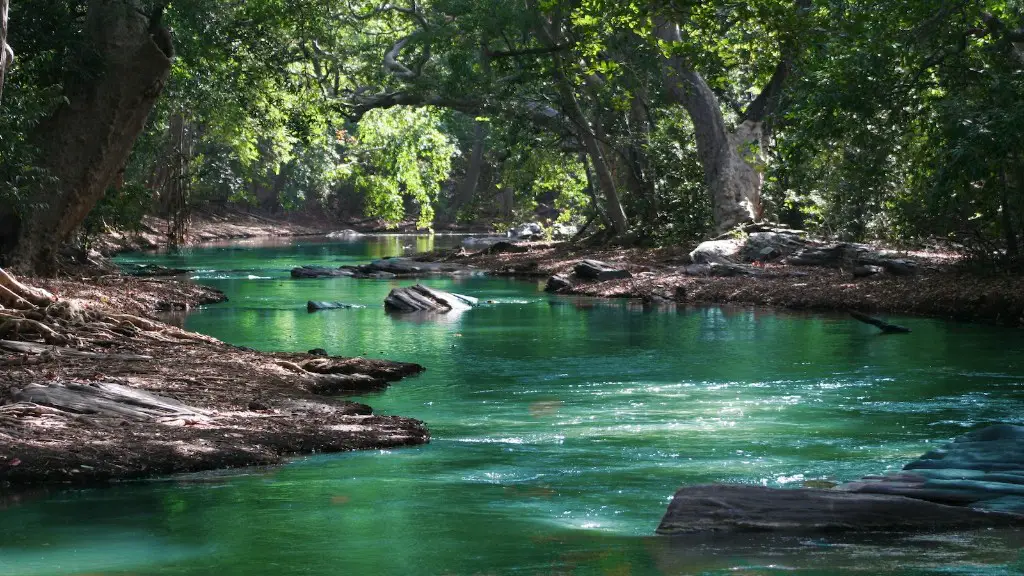Pollution
The people that live near Lake Victoria face some unique pollution challenges. Over the past decade, the lake’s limited capacity for oxygen has caused an increase in domestic and industrial waste being dumped into the lake. This has caused the lake’s eutrophication levels to rise, resulting in heavy contamination of the water. The surrounding population is already feeling the effects, with the water becoming harder to clean and drink.
Experts have predicted that if immediate steps aren’t taken to reduce pollution in the Lake Victoria region, the entire ecosystem will be put at risk. The effects of this pollution are felt by the people of Uganda, as they’re exposed to contaminated water and air, leading to public health problems, such as respiratory and skin diseases. Moreover, it affects livelihoods, such as fishing, which depends heavily on the lake’s resources.
In an effort to reduce the amount of pollution affecting the lake and its inhabitants, the governments of Uganda, Kenya, and Tanzania – the three countries that share the lake – have implemented regulations. For instance, in Uganda, the Ministry of Water and Environment has set limits on the number and type of pollutants that can be released into the lake. However, despite these efforts, some companies continue to illegally dump industrial waste into the lake.
Lack of Access to Clean Water
The people living by Lake Victoria are faced with a severe water crisis. One of the major aspects of this issue is the lack of access to clean drinking water. Despite the lake being the main source of water for the region, many communities lack access to clean, safe water which affects the health of millions of people. This is because most water sources near the lake are contaminated with toxic chemicals, such as mercury and lead, as well as infectious microorganisms and parasites that can cause waterborne illnesses.
Due to the lack of access to clean drinking water, many families resort to buying water from water vendors. These vendors are known to use contaminated water, leading to a myriad of health issues, especially amongst children. Furthermore, the lack of access to clean water affects people’s ability to carry out basic activities such as washing their hands, which further leads to water and sanitation-related diseases, such as diarrhea and cholera.
Access to clean and safe drinking water is essential in order to ensure healthy and productive lives for the people of Uganda and the other countries sharing the lake. This would involve providing the necessary infrastructure and services, such as water pipes and water treatment plants, for the communities in the area.
Depletion Of Fish Resources
Fishing is an essential part of the local economy and is relied on heavily by the people living in and around Lake Victoria. The lake has a large variety of fish species, which are a source of food and income for many fishing communities. However, the overfishing and illegal fishing practices in the lake have led to the depletion of fish resources, impacting the livelihoods of many people.
In 2019, the Ugandan Minister of Fisheries, Ruth Nankabirwa, noted that overfishing had depleted the lake’s fish stocks by 50%, largely due to illegal fishing in the lake. This is a major issue as it has resulted in a significant decrease in the income of fishing communities in the region. The depletion of the fish stocks has had significant impacts on the livelihoods and income of thousands of fishermen and their families.
In an effort to address this issue, the governments of Uganda, Kenya, and Tanzania have enacted a number of measures, such as limiting the number of fishing permits, regulating fishing gear, increasing fines for illegal fishing, and increasing the effort to combat illegal fishing.
Over Dependence On Charcoal Production
In rural areas of Uganda and other countries around Lake Victoria, many households are dependent on the production of charcoal for their energy needs. The practice of producing charcoal is responsible for a large amount of air pollution, leading to health problems in the region. The smoke produced by burning wood produces large quantities of carbon dioxide, as well as other pollutants, such as sulphur dioxide and nitrogen dioxide, resulting in air quality problems.
Furthermore, the production of charcoal also has other negative environmental impacts, such as deforestation. This is because large amounts of wood need to be burned in order to produce charcoal, which is depleting the forests of the region. This has damaged the wildlife and caused soil erosion, leading to further environmental degradation.
In order to address this issue, alternative energy sources need to be developed. This could involve the use of renewable energy sources, such as solar and wind power, or providing access to natural gas for households to use for cooking or heating.
Flooding
The people living near Lake Victoria have been confronted with flooding in recent years due to climate change. The lake’s lake levels have risen due to increased rainfall, leading to flooding in the areas surrounding it. This has resulted in considerable damage to the infrastructure and has affected the livelihoods of many people.
The Uganda Red Cross reported that in 2016, over 13,000 people were affected by flooding in the region, leading to the displacement of thousands of people. Floods have also wiped out crops, resulting in food insecurity in the affected areas.
In order to address this issue, the Ugandan government has implemented a number of measures, such as building levees and dikes as well as investing in disaster response and preparedness. Furthermore, efforts to restore ecosystems in the region, such as water bodies and wetlands, could help reduce the impacts of floods.
Water Hyacinth
Lake Victoria has been heavily impacted by the increasing presence of the invasive water hyacinth in recent years. The water hyacinth has spread rapidly in the lake since it was first introduced in the 1980s, resulting in a loss of water quality and a decrease in the lake’s biological diversity.
The presence of the water hyacinth has also had a detrimental effect on the people living in the region. It has decreased the lake’s capacity for fishing and has blocked transportation routes, leading to economic losses for many local communities. Furthermore, it has made it difficult for communities to access safe and clean drinking water, resulting in further economic losses and damage to public health.
In order to address this issue, the governments of Uganda, Kenya, and Tanzania, have implemented efforts to remove the water hyacinth. This has included the use of mechanical removal, as well as biological control agents, such as weevils and ducks.
Increased Pressure On Natural Resources
Due to the increasing population near Lake Victoria, there has been a rise in the demand for food and other resources from the lake. This has led to increased pressure on the lake’s resources, such as fish and water, resulting in further environmental degradation.
The issue of over-exploitation of Lake Victoria’s resources has been compounded by climate change. Changes in the temperature and precipitation patterns of the region have resulted in further stress on the resources of the lake. This has led to a decrease in fish stocks and an increase in water pollution, both of which have been detrimental to the surrounding communities.
In order to address this issue, conservation initiatives, such as restrictions on fishing and the protection of protected areas, need to be implemented. This would ensure that the resources of the lake are protected and the people living in and around it are able to access them in a sustainable and equitable manner.
Human-Wildlife Conflicts
The increasing human population around Lake Victoria has led to an increase in human-wildlife conflicts in the region. The lake is home to a variety of wildlife species, such as the hippopotamus and the African elephant. This has led to increased incidents of crop raids, human attacks, and property damage by wildlife.
In order to address this issue, government initiatives, such as the development of better infrastructure, need to be implemented. This would include the construction of fences and barriers to reduce the conflict between humans and animals. Furthermore, efforts to promote harmonious coexistence between humans and animals need to be strengthened. The establishment of education programmes and awareness campaigns in the region would help raise awareness of the importance of conserving wildlife.
Lack Of Infrastructure
Despite the Lake Victoria region being a major source of income and development in the area, there has been a lack of adequate infrastructure in the region. This has hampered the economic progress of the people living in the region.
The lack of infrastructure means that there are inadequate roads, poor access to clean drinking water, and a lack of access to health care services in the region. This has exacerbated issues such as poverty, access to food, and access to education for the people living in and near the lake.
In order to address this issue, governments in the region need to invest in the development of infrastructure, such as roads and power plants. This would allow the people of the region to access basic services, such as education and health care, and access markets for their agricultural produce. Furthermore, efforts to reduce poverty and empower local communities need to be strengthened.


